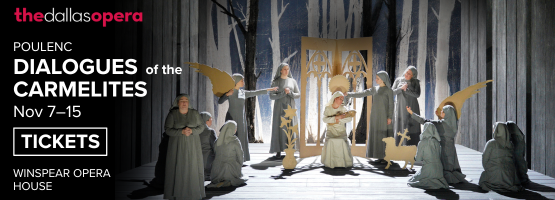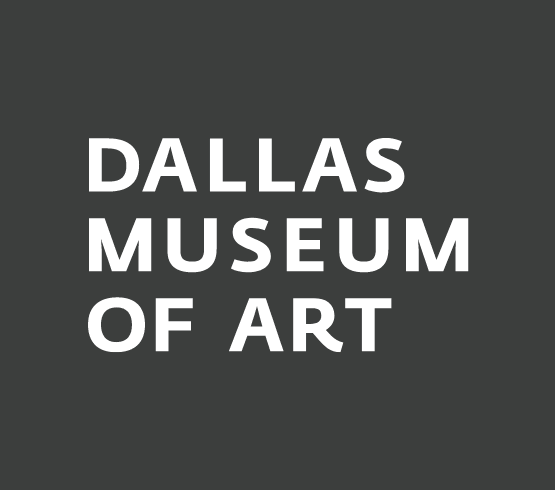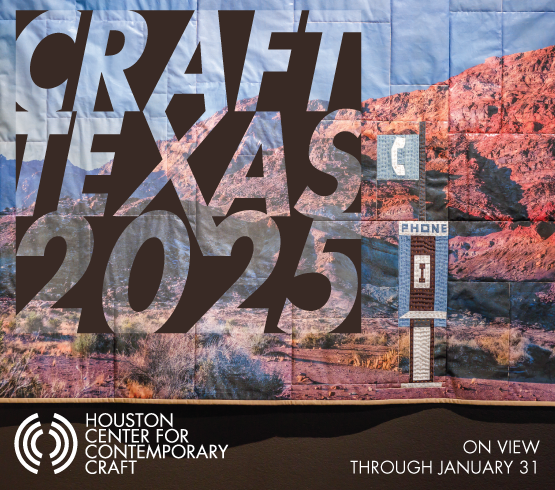Houston is a city with many identities, from Screwston, an homage to DJ Screw, and Bayou City to the simplicity of H-Town or the more commercial Energy Capital of the World. Space City, though, is more than a nickname; it speaks to a rich history of innovation and exploration entwining the city with NASA.
On view at Asia Society Texas Center through March 16, 2025, and curated by Owen Duffy, Nancy C. Allen Curator and Director of Exhibitions, Space City: Art in the Age of Artemis features the works of over 30 artists exploring the wonders of space. Inspired by NASA’s ongoing Artemis campaign to return to the moon, the exhibition highlights the profundity and awe artists are able to encapsulate in their works engaging the curiosity, technology, and mythos surrounding outer space.
“The story starts about two years ago when I first moved to Houston from New York City,” Duffy started. “One of the things I found so amazing about the city was its identity as Space City and the existence of the Johnson Space Center. It quickly reminded me of the global impact of the city.”
“My interest in outer space stems from a recognition of how art is at its most impactful when it creates a sense of wonder,” Duffy said. “To me, that reflects the sense of wonder you feel when you stare at the cosmos.”
The organization of the exhibition seeks to accomplish this through four themes: Origins, Celestial Bodies, Space Technology, and Other Worlds. Each of these themes highlights an aspect of outer space touched on by artists in the exhibition, from works inspired by the Big Bang and creation myths to artists who craft their own worlds.
“We have to start somewhere, and the idea of origins starts with the Big Bang,” Duffy stated. “Starting here felt scientifically correct and conceptually powerful, imagining the beginning of everything and how artists engage with it.”
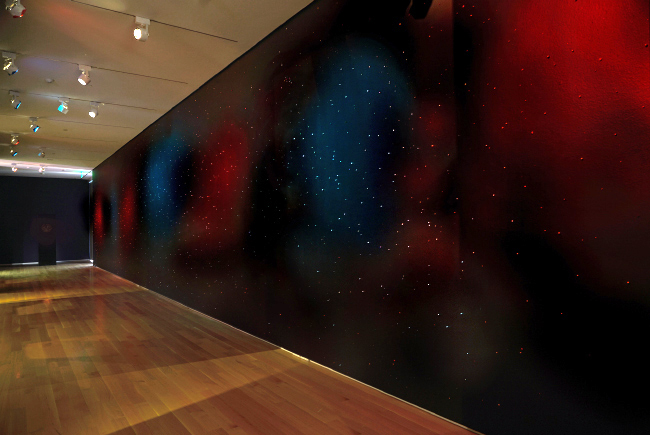
1 ⁄7
Installation view of Space City: Art in the Age of Artemis, Asia Society Texas, October 17, 2024 – March 16, 2025. © Rick Wells
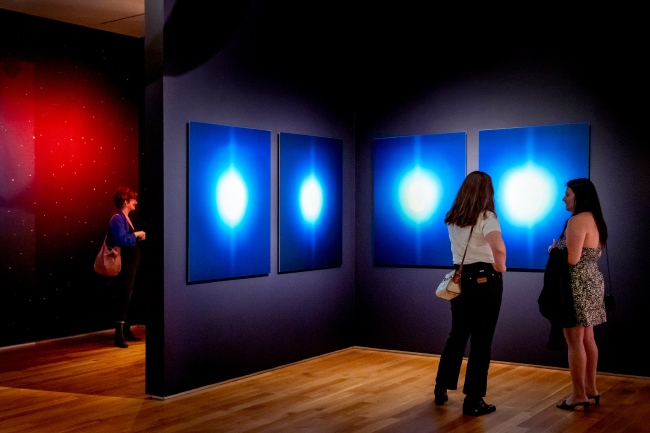
2 ⁄7
Opening reception for ‘Space City: Art in the Age of Artemis’ on Thursday, October 17, 2024, at Asia Society Texas. The exhibition is on view through March 16, 2025. Photo by Chris Dunn.

3⁄ 7
Installation view of ‘Space City: Art in the Age of Artemis,’ Asia Society Texas, October 17, 2024 – March 16, 2025. © Alex Barber
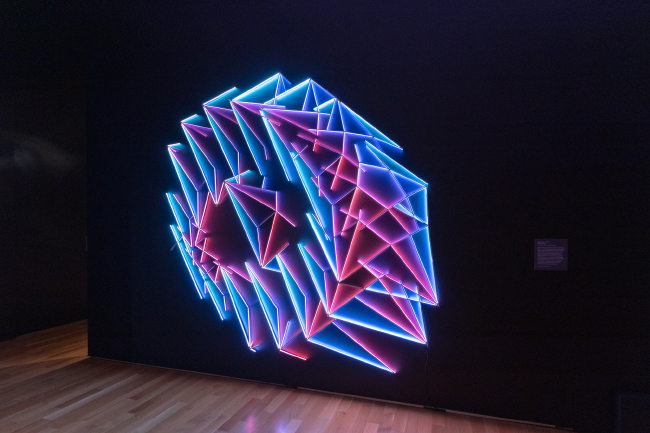
4 ⁄7
Installation view of ‘Space City: Art in the Age of Artemis,’ Asia Society Texas, October 17, 2024 – March 16, 2025. © Alex Barber

5 ⁄7
Installation view of ‘Space City: Art in the Age of Artemis,’ Asia Society Texas, October 17, 2024 – March 16, 2025. © Alex Barber
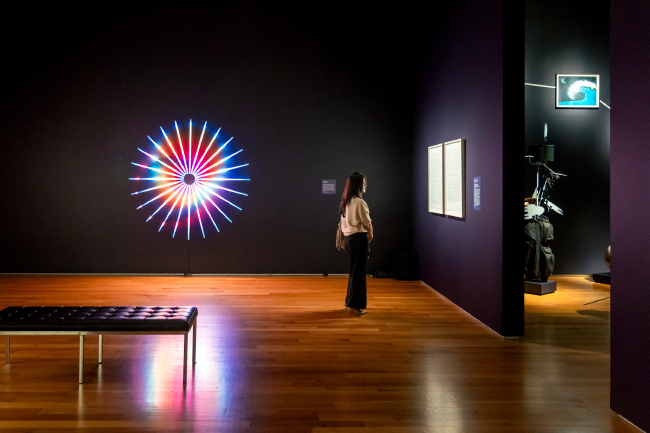
6 ⁄7
Opening reception for ‘Space City: Art in the Age of Artemis’ on Thursday, October 17, 2024, at Asia Society Texas. The exhibition is on view through March 16, 2025. Photo by Chris Dunn.

7 ⁄7
Opening reception for ‘Space City: Art in the Age of Artemis’ on Thursday, October 17, 2024, at Asia Society Texas. The exhibition is on view through March 16, 2025. Photo by Chris Dunn.
“In the Space Technology gallery, there are three mirrored panels by Thomas Vu that show the three astronauts involved in the first moon landing,” Duffy added. “It references a memory of running through Saigon as his brother took him around the city late at night to watch the moon landing. Eventually, they stumbled into a place that let them witness the historic moment.”
Finally, the Other Worlds gallery showcases artists who have built their own narratives and fiction, weaving space throughout.
“I’m really impressed by JooYoung Choi’s sculpture,” Duffy said of Choi’s massive cloth sculpture of two beings entangled, equal parts collision and embrace. “She’s known for creating the Cosmic Womb, and the two characters are sentient black stars. I led a tour of third graders, and felt that sense of wonder as they stared up at the sculpture.”
Fostering that sense of awe and wonder in visitors is a common thread throughout the exhibition, a multi-faceted collection of inventive, diverse artwork including Sunshine 2 by Ajay Kurian, a glowing sun hovering within a bronze column.
“After [Donnett’s] exhibition at Texas Southern University, it was clear to me that his work gets to the heart of Space City because his projects synthesize the urban landscape of Houston with the awe, wonder, and peace of space,” Duffy said. “What I love is how he is able to tap into a sense of contemplation of the stars with the ubiquitous material, commercially available stud earrings. There’s almost a comparison between how many of these mass-produced studs and the number of stars in the sky.”
“For me, an ideal viewer experience would result in two things,” Duffy said. “First, the smallest ember of wonder emerges inside a person. If you feel that after seeing the exhibition, it’s done its job. Second, a sense of pride in Houston as a global city. It’s been the cradle of space flight for the past 60 years in addition to being home to such incredible artists.”
—MICHAEL McFADDEN



